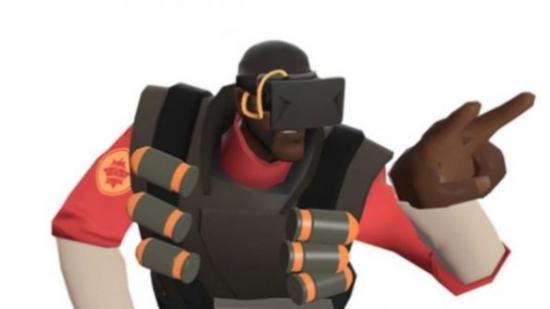Living in the wake of Steam Dev Days has been a little like watching the ships come into port in Elizabethan England – listening in awe as sailors struggle to describe potatoes.
You’ll never own one of Valve’s prototype VR kits; you’ll probably never see one. But according to the latest in a series of awestruck accounts from developers, it’s the best implementation the market will never see.
The developer, who went by the name of Feep, tested out Valve’s kit across a series of 15 demos at their Bellevue HQ earlier this week. They told NeoGAF that Valve’s solution is “lightyears ahead of the original Oculus Dev Kit”.
Resolution, traditionally the first compromise made to get VR up and running, is “no longer really a significant issue”. The screen-door effect – in which the lines between projected pixels become visible – was rendered “almost completely negligible” by a “shiny” 1080p display.
“Not actually shiny,” Feep clarified. “Shiny like in Firefly.”
Feep went on to rave about latency low enough to be unnoticeable, as well as Valve’s low-persistence display tech – the solution to judder Michael Abrash talked about in a recent blog post. In Valve’s VR setup, pixels are lit for a short amount of time per frame to avoid smearing and strobing – and Feep can concur that it works.
“The display ran at a blistering 95 Hz, and the pixels only flash for approximately 20% of that 10.52 ms refresh time,” he wrote. “You don’t notice any flickering or lack of brightness, and the plus side is that ghosting and smearing were drastically reduced. Not *completely* eliminated, mind you.”
The only major negative point in Feep’s report was reserved for the tether that tied Valve’s VR kit to a nearby PC.
“I didn’t feel free to roam or jump or twist,” the developer explained. “And presumably the wireless transmission back and forth to a base computer would add at least a few milliseconds of latency, but that’s a trade I would gladly make.”
Again: Valve’s VR kit won’t be sold commercially for reasons Feep assumes have to do with “already possessing approximately 3% of the national GDP”. But there’s a silver lining: Valve have been passing on their insights to Oculus, particularly in regard to positional tracking – the issue at the root of the Rift’s nausea problem.
Valve’s tracking solution involves sticking QR code-like symbols on the walls to ensure the headset-mounted camera can get an optical read on its position.
“There was a downside (literally), though,” pointed out Feep. “Because there were no QR codes littering the floor, looking straight down caused the system to lose its positional tracking.”
What’s more, Feep noted that “anyone visiting your home, without prior knowledge, would instantly assume you were a crazy person”. Would you be prepared to work with a similarly aesthetically bizarre set up to ensure the best VR experience?
Cheers, VG247.
